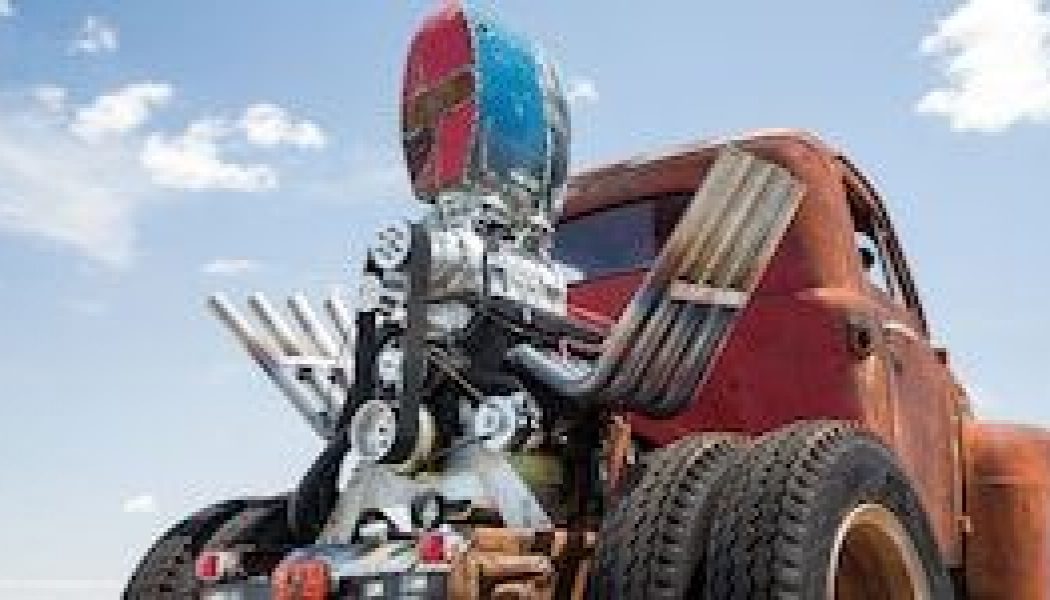It’s a 1950 Ford F-6 two-ton dump truck that does wheelies, and no one planned any of it. The Roadkill project truck known as Stubby Bob started with a surprise in episode 44 when Mike Finnegan bought the truck off a farm as a gag. We then shortened the wheelbase from 158 to 104 inches for no apparent reason and walked away from it when the brakes didn’t work well enough for a road trip. The truck carries a supercharged big-block Chevy aft of the cab and drives the rear wheels through a Gearstar 4L80E transmission and an antique boat V-drive we scored off the coolest dude ever, Slim at Slim’s Fab Farm, home of rad choppers and wheelstanding vintage vans. In one of our favorite episodes, we threw this all together and created the world’s most unlikely and treacherous wheelstander, with Stubby Bob capable of slicing a trailer hitch through asphalt like a boss.
No one’s more surprised than us that we pulled this off, and fans had many questions about the alternate reality where we win this big. Here’s the story of Stubby Bob through answers to queries posed to us via Facebook by the Roadkill Nation.
What were the original plans for Stubby Bob?
After episode 44, wherein we shortened the wheelbase on the truck, Stubby Bob was sent to storage in Georgia for a few months before being shipped to California to get weighed and certified for a title, then rotted in the Roadkill shop for another month. Finnegan and I started to look over the truck when prepping for Roadkill’s 50th episode project-car competition because we’d considered installing the supercharged big-block engine from the Crusher Camaro. What happened is what you saw in the episode: We were estimating how to fit the engine under the hood when I realized it really belonged out back. Prior to that brainchild, it was gonna be a more conventional hot rod, and probably slammed.
Why is the engine in the back—because Roadkill?
Initially it was just because it fit so much better than it would have under the hood, and honestly, it was much less work to fit it out back.
What did the suits think when they first heard about this stunt?
Virtually everyone in the office started following the buildup as soon as we mocked up the engine behind the cab. The big boss at the time loved this thing from day one, especially because there’s been no lawsuit yet.
What was the biggest challenge with the Stubby Bob project?
My normal drama is that I hate hacking up old sheetmetal. I got over that as soon as we dropped the engine out back and had the vision. By far the biggest question the whole time was if it would or would not wheelie. We knew we could do it with the engine mounted really far back for weight transfer and leverage over the rear axle, but it looked goofy to do that, so we decided to move the engine forward where it looked most neato. But that risked the sure-fire wheelstands.
Why use a Chevy engine in a Ford?
We tried pretty hard to use a 460 big-block Ford, but it was well more than double the cost of what we spent on the 454 Chevy—mostly because the blower kit was so much more expensive.
Why go with the 454 over a blown LS engine with EFI?
Image! The wheelstanders of the ’60s and ’70s all had big-blocks, usually with 8-71 blowers. If we could have easily used Enderle mechanical injection on alcohol, we would have.
What are all of Stubby Bob’s engine specs?
We dunno! In true Roadkill style, the engine is just patched together. The long-block is a 454ci Gen VI big-block Chevy from a late-’90s Chevy 3/4-ton truck. We bought this from prolific gearhead freelancer Richard Holdener for $1,000—likely a tidy profit for ol’ Richie after he snagged it from a junkyard and used it for some dyno testing. He mentioned that it made 900 hp or something like that with a big turbo, and Finnegan asked no more questions when he bought it. We don’t even know the cam specs.
We do know the heads are iron oval-ports. The supercharger is a Weiand 8-71, installed as a complete kit with the intake and belt drive. The carbs are a pair of the Holley supercharger-specific 850-cfm double-pumpers we’ve used a number of times. They work perfectly out of the box. We also got the Weiand fuel-inlet and linkage kits. The zoomie-style headers were made by Finnegan from a Hooker kit.
How difficult was it to make the blower fit the newer-generation big-block?
In the episode, we discovered the Weiand kit was not intended for Gen VI engines. The intake manifold is for rectangle-port heads and the Gen VI stockers are oval-ports, but that’s a mismatch that can work when you use rec-port gaskets and some silicone. We also had to grind the intake manifold at the gasket surface to make it fully seat onto the heads.
Would you consider the Crusher Camaro’s blown big-block as a replacement for the current big-block in Stubby Bob?
The most-asked-about engine at Roadkill is the Weiand-blown 489ci engine that was in our ’67 Chevy Crusher Camaro before we removed it on a live video feed and installed an LS7. That Crusher engine has been discussed for a number of vehicles, but it’s so similar to the one currently in Bob that there’s no reason to swap it out.
What will happen to the old flathead motor?
Stubby Bob came from the factory with a 239ci Ford flathead V-8 with 100 hp; it was the 8BA/8RT style popular with retro hot rodders. It ran great! I’m hanging onto it, hoping to use it in a flatfender Jeep or perhaps as a core for a Bonneville race car.
How much horsepower and torque is the motor putting down to the wheels?
We have never dyno-tested the engine in Stubby Bob. We’ve been telling people 600 hp at the crank, which is very conservative. In the past, I’ve made 750 hp with a similar 454 Chevy with the same blower and same pulleys but with a solid roller cam and rectangle-port heads. Bench race it from there, and take your best guess.
Was there any cooling on the engine?
HOT ROD Garage’s Lucky Costa built the cooling system using a Jeg’s aluminum radiator and fans up front and plumbing the water to the rear using exhaust-pipe steel tubing with universal flex hoses at the connections. The downer is that the radiator cap is lower than the engine, so the system needs to be filled by removing the hose from the thermostat housing.
What was the reaction of the HOT ROD Garage guys when they discovered the hole in the Bonemaro’s hood?
In the buildup episode, we cut some sheetmetal from the unused hood of HRG’s project turbo-LS Camaro and used it for our carb scoop. We considered it payback for when they stole the seat from General Mayhem in one of their episodes. Lucky endorsed it. Tony Angelo has been silent about it. But probably irritated.
Why did you use a V-drive instead of a 4×4 transfer case with an unused output? Wouldn’t the extra gearing make wheelies easier and the parts to do it cheaper?
Our challenge was figuring out how to drive the rear axle when the engine was mounted directly above it with the transmission pointing forward. We solved this using a V-drive, a gearcase that takes forward-pointing input and transfers it to rearward output, as is commonly done with propeller-powered speedboats.
We could have used a transfer case from a 4×4 truck, but we would have had to use the output that was designed for the front axle, which is offset from center. The V-drive is inline to match the centered rear axle in the truck.
What kind of ratio is the V-drive? Is it gear-to-gear or chain-driven?
Slim traded us a conventional, 1967-vintage Casale V-drive for a toploader out of his van. It’s a gear-driven setup. V-drives commonly have over- or underdrive ratios; ours did not seem to be 1:1, but we did not bother to check the ratio. It’s not like we would have changed it even if we knew what it was.
What is the process of setting up an electronically controlled transmission with a carbed engine?
The trans we used was a modern, electronic 4L80E four-speed overdrive from Gearstar Transmissions. There are many controllers you can buy to use these without a factory computer, and they require inputs for rpm, speed, and throttle position. Ours was from CompuShift.
Was Stubby Bob still running the same rearend from the first episode and the 50th shootout episode?
Yup!
What gear ratio and/or ratios are in the rearend? I remember you guys saying it was a two-speed rearend.
Yeah, it’s an Eaton-built two-speed, common in trucks like this. From the factory, it was vacuum-shifted from a knob under the dash and could be used to split gears. They came in versions with ratios of 5.83:1 and 8.11:1 or with 6.33:1 and 8.81:1. We don’t know which version we have. We are pretty sure we ran it in the high ratio (5.83:1 or 6.33:1) but can’t be certain.
Do you guys not have some insurance representative saying, “No, we would rather you didn’t have an exposed prop shaft right next to your legs while you do a wheelie without a harness?”
Don’t ask, don’t tell.
Did you ever get rid of the spit rims?
Nope! The old truck uses 20-inch wheels that retain the tire beads with antiquated and fragile locking rings that you saw getting swapped in episode 44 when we first got Bob. These wheels are terrifyingly dangerous, and no one should be putting big power through them or doing wheelies on them.
Does the engine starve of oil because it is getting thrown into such an extreme angle?
When the truck is doing a wheelie at full tilt, sure, oil pressure becomes optional as the lube flows away from the oil-pump pickup tube in the pan. But we’re talking about losing pressure for maybe a second, and we’re talking Roadkill. So it’s fine.
Why did Finnegan let off the pedal during the wheelie and let the truck slam to the ground!?
True, best practice in a big wheelstand is to stay on the throttle to carry out a softer landing, and you can short-shift the trans into second rather than lifting off the throttle to reduce power and bring the front end down. Finnegan says he was thrown forward when the bumper hit the ground during the wheelie, tossing his foot off the pedal and causing him to crash down and bounce.
How many cameras were used to get all the cool shots?
Our crew is drastically smaller than any “real” TV show. During the wheelie scene, we only had two camera operators, one shooting live action and another on the slow motion. One more camera was on a fixed tripod. We had two GoPro cameras inside the cab, one under the front suspension, one on the trailer hitch, and one looking rearward at the engine.
How long was the mark on the ground from the wheelie?
Oh, we expect it’ll be there for a loooong time. Wait, you mean distance? Dead reckoning, says one mark at about 2 feet and a second contact at 8.
How long until the 66-year-old suspension breaks from landing those killer wheelies?
The suspension had a lifespan of let’s say 1 millisecond after re-entry. The driver side front leaf spring broke in half at the rear mount.
Any concerns about the fuel tank being that close to the pavement once it stands up?
You bet! During the buildup, as we mounted the beer-keg fuel tank between the rear framerails, we spent a lot of time with straightedges trying to figure out if it was possible for any of the fittings or the tank itself to contact the ground in a worst-case scenario. It wasn’t.
Wondering if you broke the motor plates on last last run?
Watch the video, and it sure looks like the aluminum motor plate is gonna let go of the big-block, but it didn’t. We inspected it after seeing the replay, and there were no cracks or bending. Finnegan did a great job on that motor-mount plate. We think the truck’s frame is a lot more flexible than we’d hope.
Did you collect on the bet?
In the wheelie episode, we took a lot of guff from our pal KJ Jones (check out KJ on the premiere episode of Shift Talkers!), the official Roadkill naysayer. I really didn’t think a wheelie was gonna happen, but Kaje harangued us so much that I threw down a hun that said we’d drag the hitch on the ground. True to honor, KJ had the green in hand when we showed our stuff, but I turned it down. It was all in good fun, and we needed the motivation.
Can Stubby Bob do burnouts?
No! That’s the shocker. Stubby Bob won’t smoke the tires at all. It just moves out or up. I think the gears are so low that there’s no wheel speed and a lot of pinion-gear climb, plus the weight of the engine is over the centerline of the rear axle, which makes for a lot of traction.
Will Stubby Bob cruise at 70? What’s it run at the dragstrip?
Yes, it’ll probably cruise 70. We did about 60 in testing before the wheelie, thanks to tall tires and overdrive. But the front-suspension situation is super sketchy after the wheelie, and we have not had time to fix it or take it to a dragstrip. We’d probably stick to an eighth-mile.
How does something like this (as wonderful as it is) remain eligible for road registration?
Didn’t your mamma teach you how to not get caught? Just remain inconspicuous. That’s our secret.
Will you ever let Slim from Slim’s Fab Farm have a go with it?
Slim totally hooked us up with the good V-drive and made the episode happen! Dude is our bro and can wreck Bob any time he wants.
How loud is it inside Stubby Bob?
The open zoomies are brutal. Stubby Bob is our loudest vehicle ever, and it’s not just loud but also piercing. Finnegan made a little kid cry at the Car Craft Summer Nationals just by whacking the throttle.
What was the total cost of Stubby Bob?
You don’t really want to know. The truck and new tires were $3,000, and the engine was $1,000. Holley donated the blower, carbs, fuel pumps, AN lines, and headers, and those add up to at least $7,000. The Gearstar Level 4 trans and converter and all the extras are about $4,000. Throw in all the other little junk, and it’s pretty much $17,000.
How much time did the project take from getting it from Finnegan’s house to marking up 8 feet of road?
Keep in mind that video production slows down car work quite a bit. Two of us worked on it for three days for the first episode. For the engine installation and V-drive and everything, Finnegan worked the hardest, putting in about five days. I was in and out for three days, and Lucky came in for two days.
If you could redo the Stubby Bob build, what would you change?
We didn’t think about it until you asked because we still had the glow of victory, and nothing else matters. We’d do it the same, I guess, but we have ideas about how to make it more functional, like adding a wheelie bar and creating a softer long-travel front end for better landings. A trans brake would ensure good launches. We hate the split-rim wheels, but it’s hard to find a cool-looking solution. The cooling system needs more flex joints so it doesn’t crack. And maybe we should glance at the brakes.
Have you ever had as much fun in your life?
No way. Dream fulfillment engaged!
Who Did the First Wheelstand?
HOT ROD archival photos show drag-race cars capable of pulling the front wheels off the ground way back in the early ’50s, but the big wheelstands didn’t come until the advent of the blown nitro-burning slingshot dragsters of the late ’50s. The exhibition sport of wheelstanding was invented in 1965 with the Dodge Little Red Wagon, a forward-cab A100 pickup that the factory built as an NHRA experimental racer by placing a 426 Hemi just behind the seats. It was supposed to be a real race car, but the truck ended up just pulling big wheelies all the time. It became known as The Original Wheelstander, and several versions were campaigned for decades by Bill “Maverick” Golden.
The second most well-known wheelstander was the Hurst Hemi Under Glass, a Plymouth Barracuda with a Hemi engine under the enormous backlight. There were many iterations of this car, as well, driven by Bob Riggle, and you may have seen the most recent one get barrel-rolled with Jay Leno riding shotgun on an episode of Jay Leno’s Garage.
The late ’60s saw an ever-increasing array of showmen in wilder and wilder exhibition wheelstanders, from Corvair wagons to VW pickups to Corvettes and even tanks, school busses, and stagecoaches. But not one of ’em was a ’50 Ford dump truck.


![Bruce Springsteen and the E Street Band Announce New Tour Dates in the US, Canada [UPDATED]](https://www.wazupnaija.com/wp-content/uploads/2023/02/bruce-springsteen-and-the-e-street-band-announce-new-tour-dates-in-the-us-canada-updated-327x219.jpg)







